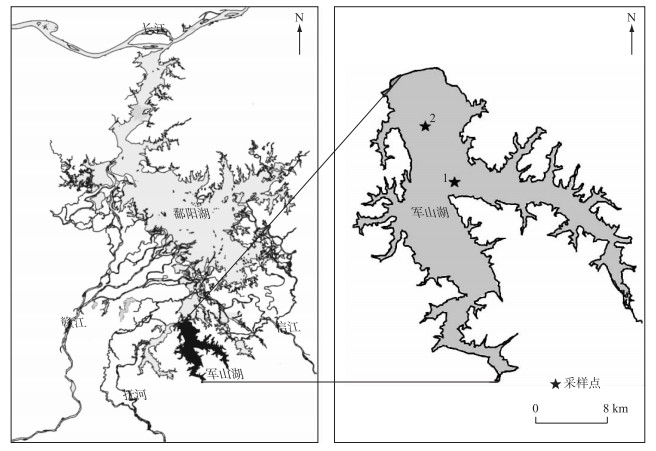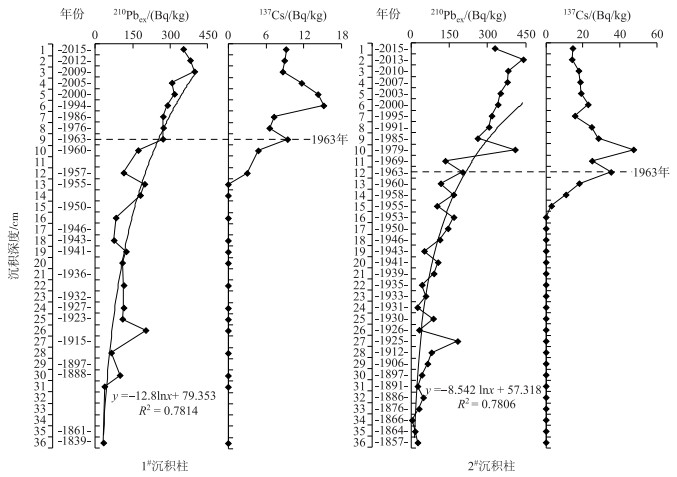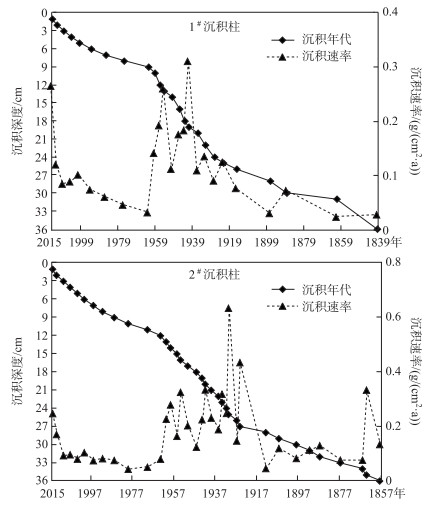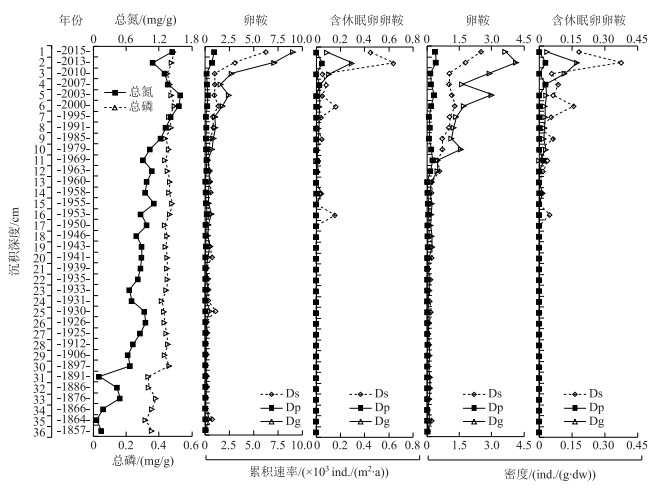枝角类,隶属节肢动物门、甲壳纲,是水体生态系统的重要组成部分[1].一方面它们能够滤食藻类和有机碎屑,是水体生态系统的初级消费者;另一方面又是鱼类和无脊椎动物捕食者的饵料[2].此外,它们对湖泊生态环境的变化十分敏感,已成为评价湖泊生态环境变化的重要指标之一[3].溞属种类是枝角类的重要类群,其生活史具有世代交替的现象.在环境条件良好时,行孤雌生殖,能够快速扩大种群;但当环境条件恶化时(如捕食压力增大、种群密度过大、食物缺乏等),孤雌生殖雌体不仅产出雌体,还产出雄体,行两性生殖.通常,雄体与两性生殖雌体交配,而后受精,两性生殖雌体排出1个或2个受精卵进入卵鞍内,即形成含休眠卵的卵鞍[4].而未与雄体交配受精的两性生殖雌体蜕皮后产下的卵鞍,即为空卵鞍[5].产出的含休眠卵卵鞍通常降落到沉积物中,在环境条件好转时休眠卵重新萌发,继续进行孤雌生殖[6-7].因此,自然水体的沉积物中通常含有大量的卵鞍,尤其在富营养化的水体中[8].
军山湖(28°24′~28°38′N,116°15′~116°28′E)位于江西省进贤县西北部,是一个典型的鄱阳湖阻隔湖泊.军山湖原系鄱阳湖的一部分,由于与鄱阳湖的自然联通,湖泊具有良好的生态系统.但1958—1959年建闸筑堤后,隔断了军山湖与鄱阳湖的联系.阻隔后的军山湖水体生态系统发生了较大变化,水流变缓、水体与鄱阳湖的交换周期延长,湖泊对污染物的净化和水体自净能力下降[9].建坝后的军山湖开始大力开展渔业养殖等活动,加上农业的非点源污染,水体的营养水平快速上升[10].自2010年,军山湖水质已达到中度营养状态,并向水体富营养化发展[11-13]. 2014—2015年,军山湖水体总氮和总磷浓度的平均范围分别为0.042~ 0.359 mg/L和0.01~0.071 mg/L[14].有研究显示,水环境的改变不仅能够加速水体的富营养化过程,还有利于浮游甲壳动物的生长繁殖[15-16].军山湖的枝角类多以小型种类(如象鼻溞、秀体溞、网纹溞和裸腹溞)为主,大型的溞属种类仅在冬季和春季形成优势种群[17-18].不管怎样,有关军山湖沉积物中溞属枝角类卵鞍的研究尚未见报道.需要说明的是,国内学者早期对溞属种类的分类一般参照《中国动物志·淡水枝角类》[1],该分类以形态描述为主.近年来,随着分子生物学技术在溞属种类分类中的不断应用,国内外学者对溞属种类的系统进化与命名进行了广泛的探讨,并将我国原先命名的透明溞(Daphnia hyalina)更正为盔形溞(D. galeata)[19-20],将隆线溞(Daphnia carinata)或拟同形溞(Daphnia similoides)更正为中华拟同形溞(D. similoides sinensis)[21-22].
通常,湖泊食物网的一些重要组成部分(如硅藻、植物花粉、枝角类残余物)可以较好地保存在湖泊沉积物中.因而,它们在沉积物中的生物量、群落结构等信息可以用来重建湖泊生物群落变化的历史,并为评价不同环境压力的长期生态效应提供基础数据[23-24].在云南洱海,沉积物中的枝角类群落结构真实地反映了近百年来多重环境压力(富营养化、水生植被退化以及外来鱼类引入等)对枝角类群落结构的影响[25].在安徽巢湖,保存在沉积物中的溞属种类卵鞍能够再现巢湖溞属种类的历史演变过程[26].总之,古湖沼学的研究可以为探讨湖泊生态系统的长期变化提供重要信息.
军山湖作为一个典型的阻隔湖泊,建坝前后不同的湖泊环境压力对其枝角类的群落结构特征是否存在影响,目前尚缺乏相关报道.本文研究了军山湖沉积物中溞属种类总卵鞍和含休眠卵卵鞍密度的长期变化,并探讨了军山湖沉积物中营养盐含量的变化对溞属种类总卵鞍和含休眠卵卵鞍分布的影响.通过对沉积物中营养盐含量和溞属种类微化石的长期变化进行分析,其研究结果可为重建湖泊环境的历史变化及溞属种类的长期演替提供参考.
1 材料与方法 1.1 样品采集与分析2015年8月在江西省军山湖设置2个采样点(1#:28°32′33.917″N,116°20′32.964″E;2#:28°34′13.917″N,116°19′03.120″E)(图 1),用柱状采泥器(购于中国科学院南京地理与湖泊研究所,直径为8.4 cm)在每个采样点分别采集3根柱状沉积样(柱长36 cm).其中,1根沉积柱用于沉积物中总氮、总磷含量及沉积年代的测定,另2根沉积柱用于沉积物中溞属卵鞍的鉴定与计数.用1 cm切割环对每个柱状沉积样按每隔1 cm进行切割. 1 cm样品分别装入封口塑料袋中,带回实验室,在冰箱中4 ℃下保存.将每个采样点中的1根柱状沉积样的所有1 cm样品分别放在阴凉处风干,研磨后用180目筛网(孔径为0.08 mm)过筛,并将筛后的样品放入干燥器内以备柱状沉积样的年代测定及沉积物中总氮、总磷含量的测定.

|
图 1 军山湖采样点分布 Fig.1 Distribution of sampling sites in Junshan Lake |
将每个采样点剩余的2根柱状沉积样的所有1 cm样品,分别用蒸馏水清洗,用200目(孔径为0.074 mm)的滤网进行过滤,将过滤后的剩余物装入50 ml的白色塑料瓶中.将剩余物放在OLYMPUS(CX21)显微镜下进行观察,并对溞属卵鞍(含休眠卵卵鞍)进行鉴定和计数.溞属卵鞍的鉴定参照文献[27, 1].
沉积物中溞属总卵鞍和含休眠卵卵鞍的累计速率计算公式为:C=Ni/S/Yi.式中,C为溞属总卵鞍(或含休眠卵卵鞍)的累积速率(ind./(m2·a));Ni为第i个1 cm沉积层中溞属总卵鞍(或含休眠卵卵鞍)的数量(ind.);S为每1 cm沉积层的面积(m2);Yi为第i个1 cm沉积层所表示的沉积年代(a).
沉积物中溞属总卵鞍和含休眠卵卵鞍的密度表示为:1 cm沉积层中每克干重沉积物含有的数量(ind./(g·dw)).
1.3 沉积物中总氮、总磷含量的测定每个采样点中用于测定总氮、总磷含量的1根柱状沉积样的所有1 cm风干样品,研磨后用180目筛网(孔径为0.08 mm)过筛,分别称取5 g过筛后样品,用过硫酸盐消化法测定样品中的总氮和总磷含量[28].
1.4 柱状沉积样的年代测定柱状沉积样的年代测定在中国科学院南京地理与湖泊研究所湖泊与环境国家重点实验室中进行.每个1 cm的沉积层,称取2~5 g经风干研磨过滤的土样放入测样盒中密封10 d.沉积样品的210Pb和137Cs比活度采用高纯锗低本底γ能谱仪(美国ORTEC公司)测定.测定时间为40000~80000 s. 210Pb和137Cs的标准样品由中国原子能科学研究院提供. 137Cs的首次最大沉积峰对应于1963年北半球最大137Cs沉降[29-30].
2 结果 2.1 军山湖柱状沉积样的年代序列及沉积速率根据137Cs和210Pbex的比活度垂直分布情况(图 2),确定9和12 cm对应的年份分别为军山湖1#和2#沉积柱的1963年.在1923—1958年,军山湖1#和2#沉积柱的沉积速率均呈现较高的水平,分别在1941年(19 cm)和1930年(25 cm)达到最大值(即0.311和0.635 g/(cm2·a));而在1958—2015年,军山湖沉积柱的沉积速率呈先明显减小而后增加的趋势(图 3).

|
图 2 军山湖1#和2#沉积柱137Cs和210Pbex比活度的垂直分布 Fig.2 Vertical distribution of 137Cs and 210Pbex activities in the 1# and 2# sediment core in Junshan Lake |

|
图 3 军山湖1#和2#沉积柱年代及沉积速率 Fig.3 Ages and accumulation rates of the 1# and 2# sediment core in Junshan Lake |
在军山湖沉积物中,共鉴定出溞属枝角类卵鞍3种,分别为中华拟同形溞(D. similoides sinensis)、蚤状溞(D. pulex)和盔形溞(D. galeata).中华拟同形溞卵鞍呈狭长豆芽状,内含两个休眠卵,卵的长轴与卵鞍背侧平行.蚤状溞卵鞍呈D型,内含两枚休眠卵,卵的长轴与卵鞍背侧相垂直.盔形溞的卵鞍形状与蚤状溞相似、稍长,内含两枚休眠卵,卵的长轴与卵鞍背侧倾斜成一定角度(图 4).

|
图 4 军山湖沉积物中3种溞属种类卵鞍的形态(A:中华拟同形溞; B:蚤状溞; C:盔形溞) Fig.4 Shapes of ephippia of three Daphnia species in the sediment of Junshan Lake (A: D. similoides sinensis; B: D. pulex; C: D. galeata) |
军山湖1#沉积柱中总氮和总磷含量的变化范围分别为0.21~1.28和0.28~0.44 mg/g,其平均值分别为0.52和0.37 mg/g. 1958年建坝前,从下层到上层(36~11 cm)1#沉积柱中总氮含量呈现较小幅度的上升,而总磷含量呈现逐渐下降的趋势. 1959年建坝后,从下层到上层(10~1 cm)1#沉积柱中总氮含量呈现逐步升高的趋势,而总磷含量变化幅度较小(图 5).

|
图 5 军山湖1#沉积柱中3种溞属总卵鞍和含休眠卵卵鞍的密度、累积速率及总氮、总磷含量 (Ds:中华拟同形溞; Dp:蚤状溞; Dg:盔形溞) Fig.5 Densities and accumulation rates of total ephippia and ephippia containing resting eggs of three Daphnia species and nutrient contents at the 1# sediment score in Junshan Lake (Ds: D. similoides sinensis; Dp: D. pulex; Dg: D. galeata) |
在军山湖1#和2#沉积柱中,均鉴定出中华拟同形溞、蚤状溞和盔形溞的卵鞍(包括含休眠卵的卵鞍).
在军山湖1#采样点,1839—1936年(36~20 cm)的沉积层中3种溞属种类总卵鞍的累积速率均处于较低的水平(0~0.37×103 ind./(m2·a)). 1937—1958年(19~11 cm)的沉积层中3种溞属总卵鞍的累积速率较为平稳(0.09×103~1.51×103 ind./(m2·a)).自建坝后,1959—2015年(10~1 cm)的沉积层中3种溞属总卵鞍的累积速率呈现逐步升高的趋势,尤其是在2009—2015年(3~1 cm)3种溞属种类总卵鞍的累积速率明显升高.在36~25 cm的沉积层中,3种溞属种类的总卵鞍密度处于较低水平(0~0.11 ind./(g·dw)), 且均没有发现3种溞属种类含休眠卵卵鞍的存在.在24~11 cm的沉积层中,3种溞属种类的总卵鞍密度开始出现明显上升(0.02~0.63 ind./(g·dw)),中华拟同形溞、盔形溞和蚤状溞分别在24、20和13 cm沉积层第1次出现含休眠卵的卵鞍.在10~1 cm的沉积层中,3种溞属种类的总卵鞍密度和含休眠卵卵鞍密度呈现明显升高的趋势(图 5).
军山湖2#沉积柱中总氮和总磷含量的变化范围分别为0.06~1.57和0.32~0.49 mg/g,其平均值分别为0.88和0.44 mg/g. 1958年建坝前,从下层到上层(36~14 cm)2#沉积柱中总氮含量呈现逐步升高的趋势,而总磷含量先升高而后趋于稳定. 1959年建坝后,从下层到上层(13~1 cm)2#沉积柱中总氮含量增加的速率加快,而总磷含量变化幅度仍然较小(图 6).

|
图 6 军山湖2#沉积柱中3种溞属总卵鞍和含休眠卵卵鞍的密度、累积速率及总氮、总磷的含量 (Ds:中华拟同形溞; Dp:蚤状溞; Dg:盔形溞) Fig.6 Densities and accumulation rates of total ephippia and ephippia containing resting eggs of three Daphnia species and nutrient contents at the 2# sediment score in Junshan Lake (Ds: D. similoides sinensis; Dp: D. pulex; Dg: D. galeata) |
军山湖2#采样点,1857—1939年(36~21 cm)的沉积层中3种溞属种类总卵鞍的累积速率均处于较低的水平(0~0.47×103 ind./(m2·a)). 1941—1958年(20~14 cm)的沉积层中3种溞属总卵鞍的累积速率较为平稳(0.29×103~0.70×103 ind./(m2·a)).建坝后,1959—2015年(13~1 cm)的沉积层中3种溞属总卵鞍的累积速率呈现逐步升高的趋势,尤其是在2010—2015年(3~1 cm), 3种溞属种类总卵鞍的累积速率明显升高.在36~14 cm的沉积层中,3种溞属种类的总卵鞍密度均处于较低水平(0~0.22 ind./(g·dw)).中华拟同形溞和盔形溞分别在16和14 cm的沉积层中首次发现含休眠卵的卵鞍.在13~1 cm的沉积层中,中华拟同形溞和盔形溞的总卵鞍密度和含休眠卵卵鞍密度呈现明显上升的趋势(图 6).
2.4 军山湖沉积物中溞属种类卵鞍密度与营养盐间的关系Pearson相关性分析显示(表 1),军山湖1#沉积柱中的总氮含量与中华拟同形溞、蚤状溞和盔形溞的总卵鞍和含休眠卵卵鞍的累积速率之间均存在极显著性相关(P < 0.01),总磷含量与3种溞属种类的总卵鞍和含休眠卵卵鞍的累积速率间均无显著性相关(P > 0.05). 2#沉积柱中的总氮含量(P < 0.01)和总磷含量(P < 0.05)均与3种溞属种类总卵鞍的累积速率之间均存在显著性相关.此外,2#沉积柱的总氮含量和总磷含量与中华拟同形溞的含休眠卵卵鞍的累积速率之间均存在显著性相关(P < 0.05),而与蚤状溞和盔形溞的含休眠卵卵鞍的累积速率之间均无显著性相关(P > 0.05).
| 表 1 军山湖沉积物中3种溞属总卵鞍和含休眠卵卵鞍的累积速率与营养盐之间的相关性 Tab.1 Pearson correlation coefficients for the accumulation rates of total ephippia and ephippia containing resting eggs of three Daphnia species with the nutrients in Junshan Lake |
沉积物是湖泊的重要组成部分,内含丰富的营养盐[31-32].湖泊沉积物是指示湖泊及其流域环境演变过程中蕴含生物、物理、化学信息的重要且有效的载体[33-34].湖泊沉积物中不同沉积层的营养盐含量可以反映不同时期水体的营养状况[26],同时沉积物中不同沉积层枝角类残余物(如溞属卵鞍)的状况能够还原历史时期水体中枝角类群落结构的动态变化[23, 35-36].本研究中,军山湖沉积物中鉴定出3种溞属枝角类的卵鞍,分别为中华拟同形溞、蚤状溞和盔形溞,它们均是我国亚热带地区的常见种类.
军山湖原系鄱阳湖的一部分,1959年建坝阻隔后,渔业养殖和湖区周围农业生产等持续扩大,导致军山湖的营养水平快速上升,水体富营养化趋势加剧.湖泊营养水平已由1958年建坝初期的贫营养状态逐步过渡到目前的富营养状态[11, 37].已有的研究表明,水体状况是湖泊沉积物中营养盐含量的重要影响因素[38].因此,随着湖泊污染的加重,湖泊沉积物中的营养水平也不断升高[39].通常,氮、磷是湖泊富营养化的关键限制性因子[40-41].在军山湖,污染物主要来自水产养殖所产生的氮、磷营养盐[14],且总氮为军山湖的首要污染物,其次为总磷[13, 42].本研究结果表明,军山湖1#和2#沉积柱中的总氮含量均随着沉积柱从底层到表层而增大,这一趋势在1959年建坝后更为显著(图 5和6).因此,不同沉积层氮、磷营养盐含量真实地反映了军山湖湖泊富营养化的演替过程.
经沉积年代测定,36 cm长的沉积柱反映了军山湖近160~180 a的演变历史.本文以1959年军山湖建坝为节点,结合军山湖沉积柱中3种溞属种类(中华拟同形溞、蚤状溞和盔形溞)总卵鞍和含休眠卵卵鞍的累积速率及密度变化状况,将其演变过程划分为3个阶段:
第1阶段:1#和2#沉积柱的底部(分别对应36~25 cm和36~17 cm),代表军山湖19世纪中叶到20世纪中叶的历史时期.此阶段,军山湖与鄱阳湖处于较早的自然联通状态,由于湖—湖之间不断地进行着水体交换,军山湖水质环境一直维持着较好的状况[9].水体营养程度较低,沉积物中3种溞属种类总卵鞍密度较低(0~0.22 ind./(g·dw)),对应的累积速率也几乎为零(图 5和6).两个采样点在此阶段均没有检测到3种溞属种类含休眠卵的卵鞍.早期的研究也表明,鄱阳湖的枝角类种类相对较少,且多以象鼻溞、裸腹溞等小型种类为优势类群[43],未见有溞属种类的描述.这与本阶段3种溞属种类卵鞍密度及累积速率几乎为零的结果相一致.
第2阶段:1#和2#沉积柱的中部(分别对应24~11 cm和16~14 cm),分别代表了军山湖1923—1958年和1950—1958年的历史时期.此阶段,军山湖与鄱阳湖仍处于自然联通状态,但由于鄱阳湖大量的洪灾累积[44],导致非点源污染总氮、总磷的输出量不断加大[45],水体的营养水平开始逐步升高.此时,沉积物中3种溞属种类总卵鞍密度开始增加(1#沉积柱:0.02~0.63 ind./(g·dw);2#沉积柱:0.01~0.21 ind./(g·dw)),累积速率也逐渐升高(1#沉积柱:0.01×103~1.50×103 ind./(m2·a);2#沉积柱:0.04×103~0.62×103 ind./(m2·a))(图 5和6).先前的研究表明,浮游动物的种类组成和数量变化与水质环境密切相关[46-48],且通过研究枝角类残余物的种类和数量可以推测湖泊沉积物中的营养状态[49-50]. Boucherle等[51]发现,在位于瑞士的3个湖泊中,溞属种类的种群密度随着湖泊水体营养化程度的加强而升高.本阶段,军山湖溞属种类卵鞍的累积速率和密度亦随着沉积柱中营养水平的升高而逐渐升高,与本阶段水体中氮、磷等营养盐的浓度变化相一致.
第3阶段:1#(10~1 cm)和2#(13~1 cm)沉积柱的表层代表了1958年军山湖建坝后的历史时期.此阶段是军山湖与鄱阳湖阻隔后湖泊水质逐步从贫营养型向富营养型过渡的阶段.由于筑坝阻隔,军山湖不能与鄱阳湖进行充分的水体交换,导致污染物在湖区内大量汇集,营养盐浓度升高.另外,从1970s末至今,军山湖大力发展渔业养殖,过多肥料的投入,也加重了湖泊的营养状况[52-53].在1#和2#沉积柱中,3种溞属种类总卵鞍和含休眠卵卵鞍密度均随着氮磷含量的升高呈现较大幅度的增加(盔形溞的卵鞍密度最大,为4.15 ind./(g·dw);中华拟同形溞含休眠卵的卵鞍密度最大,为0.54 ind./(g·dw)),它们的总卵鞍的累积速率也不断增大(盔形溞的总卵鞍累积速率最大,为9.02×103 ind./(m2·a)).其原因可能是军山湖建坝后,水流变缓、水体交换周期变长、营养水平升高,这种水环境特征有利于浮游甲壳动物的生长与繁殖[15-16].本研究中,军山湖沉积物中的营养盐含量与溞属种类卵鞍和含休眠卵卵鞍之间存在显著的相关性.同时,盔形溞总卵鞍的累积速率随着沉积柱从底层到表层的变化而明显增大,其对应的总卵鞍密度在军山湖两个采样点中均明显高于其他两种溞属种类.已有的文献表明,盔形溞成熟雌体的体长明显小于中华拟同形溞和蚤状溞[1, 27],且盔形溞具有较长的壳刺和尖的“头盔”,这些特征可能是盔形溞在湖泊中不易被捕食而占优势的重要原因[54-55].此外,盔形溞更适宜生活在较深的水体中[7].
| [1] |
Jiang XZ, Du NS. Fauna sinica:Crustacean-freshwater Cladocera. Beijing: Science Press, 1979, 102-118. [蒋燮治, 堵南山. 中国动物志·淡水枝角类. 北京: 科学出版社, 1979, 102-118.]
|
| [2] |
Burgis M. Ecology of freshwaters:a view for the twenty-first century, fourth edition. Biological Journal of the Linnean Society, 2011, 104(1): 234-234. |
| [3] |
Korhola A, Rautio M eds. Cladocera and other Branchiopod Crustaceans. Dordrecht: Springer Netherlands, 2001: 5-41.
|
| [4] |
Winsor GL, Innes DJ. Sexual reproduction in Daphnia pulex (Crustacea:Cladocera):observations on male mating behaviour and avoidance of inbreeding. Freshwater Biology, 2002, 47(3): 441-450. DOI:10.1046/j.1365-2427.2002.00817.x |
| [5] |
Deng DG, Meng Q, Mao KY et al. Effect of temperature and interspecific competition on population dynamics and sexual reproduction of Daphnia magna. Acta Ecologica Sinica, 2009, 29(12): 6351-6358. [邓道贵, 孟琼, 毛开云等. 温度和种间竞争对大型溞种群动态和两性生殖的影响. 生态学报, 2009, 29(12): 6351-6358. DOI:10.3321/j.issn:1000-0933.2009.12.005] |
| [6] |
Deng DG, Meng Q, Yin ST et al. Effect of temperature and food concentration on population dynamic and sexual reproduction of Daphnia magna. Acta Ecologica Sinica, 2008, 28(9): 4268-4276. [邓道贵, 孟琼, 殷四涛等. 温度和食物浓度对大型溞Daphnia magna种群动态和两性生殖的影响. 生态学报, 2008, 28(9): 4268-4276.] |
| [7] |
Xie LL, Xu L, Ren JJ et al. Genetic diversity and differentiation of four populations of Daphnia galeata by RAPD. Ecological Science, 2015, 34(2): 9-15. [谢理丽, 徐磊, 任晶晶等. 盔型溞(Daphnia galeata)四个地理种群遗传多样性及分化的RADP分析. 生态科学, 2015, 34(2): 9-15.] |
| [8] |
Meng Q, Deng DG. Advances in the production and hatching of resting eggs of Cladoceran. Chinese Journal of Zoology, 2008, 43(3): 154-160. [孟琼, 邓道贵. 枝角类休眠卵形成和萌发的研究进展. 动物学杂志, 2008, 43(3): 154-160.] |
| [9] |
Liu X, Qian KM, Tan GL et al. Phytoplankton community structure and its succession in isolated lakes of Poyang-Junshan Lake. Environmental Science, 2014, 35(7): 2557-2564. [刘霞, 钱奎梅, 谭国良等. 鄱阳湖阻隔湖泊浮游植物群落结构演化特征:以军山湖为例. 环境科学, 2014, 35(7): 2557-2564.] |
| [10] |
Fan H, Ji XY, Feng ML et al. An estimation on agriculture non-point source pollution input load of nitrogen and phosphorus in Lake Junshan basin. Environmental Pollution & Control, 2012, 34(1): 91-96. [樊华, 吉晓燕, 冯明雷等. 军山湖流域农业非点源污染氮、磷入湖负荷估算. 环境污染与防治, 2012, 34(1): 91-96.] |
| [11] |
Ji XY. Research on pollution loads and capacity of water environment of Junshan Lake[Dissertation]. Nanchang: Nanchang University, 2011. [ [吉晓燕. 军山湖入湖污染负荷及水环境容量研究[学位论文]. 南昌: 南昌大学, 2011. ] http://cdmd.cnki.com.cn/Article/CDMD-11902-1012290784.htm ]
|
| [12] |
Jiang LW, Chen Y, Lin T et al. Study on trophic state assessment and its driving factors of small and medium lakes in Jiangxi Province. Journal of Environmental Engineering Technology, 2012, 2(4): 303-308. [江立文, 陈杨, 林暾等. 江西省中小型湖泊水体营养状态评价及其驱动因子研究. 环境工程技术学报, 2012, 2(4): 303-308.] |
| [13] |
Zhang YP, Tao ZY, Yu ZJ et al. Preliminary investigation on plankton and estimation of silver carp and bighead carp productivity of Junshan Lake. Acta Agriculturae Universitatis Jiangxiensis, 2015, 37(3): 536-543. [张燕萍, 陶志英, 余智杰等. 军山湖浮游生物初步调查及鲢鳙鱼产力评估. 江西农业大学学报, 2015, 37(3): 536-543.] |
| [14] |
Kuang WM, Zhang M, Zhang JM et al. Comparative limnological study on annual dynamic pattern of nutrients in water column of three suburb lakes adjacent to Lake Poyang. J Lake Sci, 2016, 28(6): 1293-1305. [匡武名, 张萌, 张金美等. 鄱阳湖外围湖泊水体营养波动周年特征的比较湖沼学研究. 湖泊科学, 2016, 28(6): 1293-1305. DOI:10.18307/2016.0615] |
| [15] |
Thorp JH, Black AR, Haag KH et al. Zooplankton assemblages in the Ohio River:seasonal, tributary, and navigation dam effects. Canadian Journal of Fisheries and Aquatic Sciences, 1994, 51(7): 1634-1643. DOI:10.1139/f94-164 |
| [16] |
Branco CWC, Rocha MIA, Pinto GFS et al. Limnological features of Funil Reservoir (R.J. Brazil) and indicator properties of rotifers and cladocerans of the zooplankton community. Lakes & Reservoirs:Research & Management, 2002, 7(2): 87-92. |
| [17] |
Fang CL, Xu JX, Li Q et al. Investigation on lake fishery resources in Jinxian County. Jiangxi Fishery Sciences and Technology, 1995(4): 13-19. [方春林, 徐金星, 黎倩等. 进贤县湖泊水产资源调查. 江西水产科技, 1995(4): 13-19.] |
| [18] |
Liu BG, Tan GL, Xing JS et al. Effect of pen culture on community structure of planktonic crustaceans in Lake Junshan. Journal of Ecology and Rural Environment, 2015, 31(1): 82-87. [刘宝贵, 谭国良, 邢久生等. 围湖养殖对军山湖浮游甲壳动物群落结构的影响. 生态与农村环境学报, 2015, 31(1): 82-87. DOI:10.11934/j.issn.1673-4831.2015.01.012] |
| [19] |
Deng C. Effects of nutrient enrichment and fish stocking on zooplankton communities[Dissertation]. Guangzhou: Jinan University, 2011. [ [邓琛. 营养盐加富和鱼类补充对浮游动物群落的影响[学位论文]. 广州: 暨南大学, 2011. ] http://cdmd.cnki.com.cn/Article/CDMD-10559-1011128503.htm ]
|
| [20] |
Xu M, Zhang HJ, Deng DG et al. Phylogenetic relationship and taxonomic status of four Daphnia species based on 16S rDNA and COⅠ sequence. Acta Hydrobiologica Sinica, 2014, 38(6): 1040-1046. [徐敏, 张海军, 邓道贵等. 基于16S rDNA和COⅠ基因序列探讨四种溞类的系统关系和分类地位. 水生生物学报, 2014, 38(6): 1040-1046. DOI:10.7541/2014.153] |
| [21] |
Gu YL, Xu L, Lin QQ et al. A new subspecies of Daphnia:Daphnia similoides sinensis. Ecological Science, 2013, 32(3): 308-312. [顾杨亮, 徐磊, 林秋奇等. 新亚种-中华拟同形溞(Daphnia similoides sinensis). 生态科学, 2013, 32(3): 308-312.] |
| [22] |
Popova EV, Petrusek A, Kořínek V et al. Revision of the old world Daphnia (Ctenodaphnia) similis group (Cladocera:Daphniidae). Zootaxa, 2016, 4161(1): 1-40. DOI:10.11646/zootaxa.4161.1 |
| [23] |
Liu GM, Chen FZ, Liu ZW. Preliminary study on cladoceran microfossils in the sediments of Lake Taihu. J Lake Sci, 2008, 20(4): 470-476. [刘桂民, 陈非洲, 刘正文. 太湖枝角类微化石的初步研究. 湖泊科学, 2008, 20(4): 470-476. DOI:10.18307/2008.0410] |
| [24] |
Smol JP. The power of the past:using sediments to track the effects of multiple stressors on lake ecosystems. Freshwater Biology, 2010, 55(s1): 43-59. |
| [25] |
Liu G, Liu Z, Gu B et al. How important are trophic state, macrophyte and fish population effects on cladoceran community? A study in Lake Erhai. Hydrobiologia, 2014, 736(1): 189-204. DOI:10.1007/s10750-014-1906-5 |
| [26] |
Zhang K. Temporal and spatial variation of density of Daphnia species resting eggs in the sediment of Lake Chaohu[Dissertation]. Huaibei: Huaibei Normal University, 2016. [ [张坤. 巢湖沉积物中溞属枝角类休眠卵密度的时空变化[学位论文]. 淮北: 淮北师范大学, 2016. ] http://cdmd.cnki.com.cn/Article/CDMD-10373-1016118028.htm ]
|
| [27] |
Benzie JAH. The genus Daphnia (including Daphniopsis). In: Dumont HJF ed. Guides to the identification of the microinvertebrates of the continental waters of the world. Leiden: Backhuys Publishers, 2005: 39-50.
|
| [28] |
Qian JL, Zhang LD, Le ML. Determination of total nitrogen and total phosphorus in soil by persulfate digestion method. Soils, 1990, 22(5): 258-262. [钱君龙, 张连弟, 乐美麟. 过硫酸盐消化法测定土壤全氮全磷. 土壤, 1990, 22(5): 258-262.] |
| [29] |
Hu CM, Li Y, You L et al. 137Cs and 210Pb dating and sedimentation rate in the downstream river floodplain of Sanmenxia Reservoir. Yellow River, 2017, 39(4): 62-65. [胡春明, 李曜, 尤立等. 三门峡坝下河漫滩沉积物137Cs、210Pb计年研究. 人民黄河, 2017, 39(4): 62-65.] |
| [30] |
Lan B, Li JX, Zhang DL et al. Interpretation of 137Cs time markers of Xinjiang. Arid Land Geography, 2017, 40(3): 504-511. [兰波, 李佳秀, 张东良等. 新疆137Cs定年时标解析. 干旱区地理, 2017, 40(3): 504-511.] |
| [31] |
Jin XC, Wang SR, Jiang X. Preliminary study of the three-dimension model of the lake water-sediment interface. Research of Environmental Sciences, 2004, 17(z1): 1-5. [金相灿, 王圣瑞, 姜霞. 湖泊水-沉积物界面三相结构模式的初步研究. 环境科学研究, 2004, 17(z1): 1-5. DOI:10.3321/j.issn:1001-6929.2004.z1.001] |
| [32] |
Yu KY, Liu SM, Zhang J et al. A study on the exchange of nutrients between sediment and sea water. Environmental Chemistry, 2001, 20(5): 425-431. [玉坤宇, 刘素美, 张经等. 海洋沉积物-水界面营养盐交换过程的研究. 环境化学, 2001, 20(5): 425-431.] |
| [33] |
Anderson DE, Goudie AS, Parker AG. Global environments through the quaternary. Oxford: Oxford University Press, 2007.
|
| [34] |
Jia TF, Zhang WG, Yu LZ et al. Characteristics of nutrient elements enrichment in deposits of Chaohu Lake and its indication for environmental change during last 800 years. Scientia Geographica Sinica, 2009, 29(6): 893-899. [贾铁飞, 张卫国, 俞立中等. 近800年来巢湖沉积物营养元素富集特点及其环境演变意义. 地理科学, 2009, 29(6): 893-899.] |
| [35] |
Whiteside MC, Swindoll MR. Guidelines and limitations to cladoceran paleoecological interpretations. Palaeogeography Palaeoclimatology Palaeoecology, 1988, 62(1): 405-412. |
| [36] |
Jeppesen E, Leavitt P, Meester LD et al. Functional ecology and palaeolimnology:using cladoceran remains to reconstruct anthropogenic impact. Trends in Ecology & Evolution, 2001, 16(4): 191-198. |
| [37] |
Zhang HX, Fu HY, Zhang YP et al. Community structure and distribution in space and time of benthic animals in Junshan Lake. Acta Agriculturae Universitatis Jiangxiensis, 2015(3): 544-549. [章海鑫, 付辉云, 张艳萍等. 军山湖底栖动物种群结构与时空分布. 江西农业大学学报, 2015(3): 544-549.] |
| [38] |
He ZJ, Wu ZQ, Ni ZK et al. The influence of the river-lake relation changed on the sediments ammonia nitrogen release risk of Poyang Lake. China Environmental Science, 2014, 34(5): 1277-1284. [何宗健, 吴志强, 倪兆奎等. 江湖关系变化对鄱阳湖沉积物氨氮释放风险的影响. 中国环境科学, 2014, 34(5): 1277-1284.] |
| [39] |
Lin SM, Wang SR, Jin XC et al. Contents and distribution characteristics of soluble organic nitrogen in surface sediments of lakes. J Lake Sci, 2009, 21(5): 623-630. [林素梅, 王圣瑞, 金相灿等. 湖泊表层沉积物可溶性有机氮含量及分布特性. 湖泊科学, 2009, 21(5): 623-630. DOI:10.18307/2009.0503] |
| [40] |
Meng W, Yu T, Zheng BH et al. Variation and influence factors of nitrogen and phosphorus transportation by the Yellow River. Acta Scientiae Circumstantiae, 2007, 27(12): 2046-2051. [孟伟, 于涛, 郑丙辉等. 黄河域氮磷营养盐动态特征及主要影响因素. 环境科学学报, 2007, 27(12): 2046-2051. DOI:10.3321/j.issn:0253-2468.2007.12.019] |
| [41] |
Wu FC, Jin XC, Zhang RY et al. Effect and significance of organic nitrogen and phosphorous in the lake aquatic environment. J Lake Sci, 2010, 22(1): 1-7. [吴丰昌, 金相灿, 张润宇等. 论有机氮磷在湖泊水环境中的作用和重要性. 湖泊科学, 2010, 22(1): 1-7. DOI:10.18307/2010.0101] |
| [42] |
Wan HP, Zhang YP, Deng YH et al. Water environment quality evaluation of Junshan Lake based on fuzzy comprehensive evaluation. Jiangxi Fishery Sciences and Technology, 2015(2): 11-14. [万会平, 张燕萍, 邓勇辉等. 基于模糊综合评价法的军山湖水环境质量评价. 江西水产科技, 2015(2): 11-14.] |
| [43] |
Deng ZJ, Li Q, Cheng JF. Preliminary report on cladding in Poyang Lake-One of the studies on the natural fish food resources of Poyang Lake. Journal of Nanchang University:Natural Science, 1963, 141-151. [邓宗觉, 李羣, 程金富. 鄱阳湖的枝角类初步调查报告-鄱阳湖鱼类天然饵料资源研究之一. 南昌大学学报:理科版, 1963, 141-151.] |
| [44] |
Tang GH, Hu ZP. Change characteristics of historical flood and drought disasters in Poyang Lake Basin with a view to climate change. Resources and Environment in the Yangtze Basin, 2017, 26(8): 1274-1283. [唐国华, 胡振鹏. 气候变化背景下鄱阳湖流域历史水旱灾害变化特征. 长江流域资源与环境, 2017, 26(8): 1274-1283. DOI:10.11870/cjlyzyyhj201708017] |
| [45] |
Xu Q. Influence of different rainfall conditions and land use on non-point source pollution load in Junshan Lake[Dissertation]. Nanchang: Nanchang University, 2012. [ [徐群. 不同降雨条件和土地利用变化对军山湖流域非点源污染负荷的影响[学位论文]. 南昌: 南昌大学, 2012. ] http://cdmd.cnki.com.cn/Article/CDMD-10403-1013135083.htm ]
|
| [46] |
Hessen DO, Faafeng BA, Smith VH et al. Extrinsic and intrinsic controls of zooplankton diversity in lakes. Ecology, 2006, 87(2): 433-443. DOI:10.1890/05-0352 |
| [47] |
Wu ZB, Liu AF, Zhang SY et al. Short-term effects of drawing water for connectivity of rivers and lakes on zooplankton community structure. Journal of Environmental Sciences, 2008, 20(4): 419-423. DOI:10.1016/S1001-0742(08)62073-2 |
| [48] |
Zhang DR, Xu JY, Xu ZL et al. Distribution pattern of zooplankton in the south part of Hangzhou Bay during spring and autumn in relation to main environmental factors. Chinese Journal of Ecology, 2014, 33(8): 2115-2123. [张冬融, 徐佳奕, 徐兆礼等. 杭州湾南岸海域春秋季浮游动物分布特征与主要环境因子的关系. 生态学杂志, 2014, 33(8): 2115-2123.] |
| [49] |
Bos DG, Cumming BF. Sedimentary cladoceran remains and their relationship to nutrients and other limnological variables in 53 lakes from British Columbia, Canada. Canadian Journal of Fisheries and Aquatic Sciences, 2003, 60(10): 1177-1189. DOI:10.1139/f03-097 |
| [50] |
Hann BJ, Leavitt PR, Chang PSS. Cladocera community response to experiment eutrophication in Lake 227 as recorded in laminated sediments. Canadian Journal of Fisheries and Aquatic Sciences, 1994, 51(10): 2312-2321. DOI:10.1139/f94-234 |
| [51] |
Boucherle MM, Züllig H. Cladoceran remains as evidence of change in trophic state in three Swiss lakes. Hydrobiologia, 1983, 103(1): 141-146. DOI:10.1007/BF00028442 |
| [52] |
Chen HD. Impact of aquaculture on the ecosystem the Donghu Lake, Wuhan. Acta Hydrobiologica Sinica, 1989, 13(4): 359-368. [陈洪达. 养鱼对武汉东湖生态系统的影响. 水生生物学报, 1989, 13(4): 359-368.] |
| [53] |
Sun G, Sheng LX, Feng J et al. Relationship between fishery and eutrophication in Chinese lakes. Journal of Northeast Normal University, 1999(1): 74-78. [孙刚, 盛连喜, 冯江等. 中国湖泊渔业与富营养化的关系. 东北师大学报:自然科学版, 1999(1): 74-78.] |
| [54] |
Petrusek A, Tollrian R, Schwenk K et al. A "crown of thorns" is an inducible defense that protects Daphnia against an ancient predator. PNAS, 2009, 106(7): 2248-2252. DOI:10.1073/pnas.0808075106 |
| [55] |
Engel K, Schreder T, Tollrian R. Morphological defences of invasive Daphnia lumholtzi protect against vertebrate and invertebrate predators. Journal Plankton Research, 2014, 36(4): 1140-1145. DOI:10.1093/plankt/fbu023 |
 2018, Vol. 30
2018, Vol. 30 


